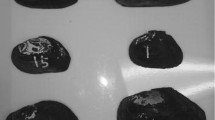Abstract
The effects of various factors on byssal thread formation have been examined in the laboratory using Modiolus demissus and Mytilus edulis. With M. demissus thread formation (threads/mussel/h0 and proportion of mussels forming threads decreased with increasing size; prior exposure to air enhanced subsequent thread formation; mechanical agitation reduced thread formation. In addition, low salinity acclimated mussels adapted more rapidly to 32 ppt than high salinity acclimated mussels did to 16 ppt; threads were not formed in the absence of calcium and/or magnesium; and there was no reduction in thread formation at temperatures as high as 27° to 28°C. M. edulis died and thread formation approached zero at temperatures exceeding 26°C.
Similar content being viewed by others
Literature cited
Brown, C. H.: Some structural proteins of Mytilus edulis. Q. Jl microsc. Sci. 93, 487–502 (1952).
Dam, L. van: On the utilisation of oxygen by Mya arenaria. J. exp. Biol. 12, 86–94 (1935).
Galtsoff, P. S.: The mystery of the red tide. Sci. Monthly 68, 108–117 (1949).
Glaus, K. J.: Factors influencing the production of byssus threads in Mytilus edulis. Biol. Bull. mar. biol. Lab., Woods Hole 135, p. 420 (1968).
Helm, M. M. and E. R. Trueman: The effect of exposure on the heart rate of the mussel, Mytilus edulis L. Comp. Biochem. Physiol. 21, 171–177 (1967).
Hutchins, L. W.: The bases for temperature zonation in geographical distribution. Ecol. Monogr. 17, 325–335 (1947).
Kinne, O.: The effects of temperature and salinity on marine and brackish water animals. II. Salinity and temperaturesalinity combinations. Oceanogr. mar. Biol. A. Rev. 2, 281–339 (1964).
Lent, C. M.: Air-gaping by the ribbed mussel, Modiolus demissus (Dillwyn): effect and adaptive significance. Biol. Bull. mar. biol. Lab., Woods Hole 134, 60–73 (1968).
Morton, J. E.: Locomotion. In: Physiology of Mollusca, Vol. 1, pp 383–423. Ed. by K. M. Wilbur and C. M. Yonge. New York: Academic Press 1964.
Reish, D. J. and J. L. Ayers, Jr.: Studies on the Mytilus edulis community in Alamitos Bay, California. III. The effects of reduced dissolved oxygen and chlorinity concentrations on survival and byssus thread formation. Veliger 10, 384–388 (1968).
Smyth, J. D.: A technique for the histochemical demonstration of polyphenol oxidase and its application to egg-shell formation in helminths and byssus formation in Mytilus. Q. Jl Microsc. Sci. 95, 139–152 (1954).
Van Winkle, W.: Effect of acclimation and experimental salinity on ciliary activity of excised bivalve gill tissue. (In preparation).
Yonge, C. M.: The seashore, 311 pp. London: Collins Clear-Type Press 1949.
— On the primitive significance of the byssus in the Bivalvia and its effects in evolution. J. mar. biol. Ass. U.K. 42, 113–125 (1962).
Author information
Authors and Affiliations
Additional information
Contribution No. 352 from the Virginia Institute of Marine Science
Communicated by G. L. Voss, Miami
Rights and permissions
About this article
Cite this article
Van Winkle, W. Effect of environmental factors on byssal thread formation. Marine Biology 7, 143–148 (1970). https://doi.org/10.1007/BF00354918
Accepted:
Issue Date:
DOI: https://doi.org/10.1007/BF00354918




